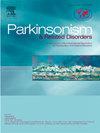Functional efficacy of the MAO-B inhibitor safinamide in murine substantia nigra pars compacta dopaminergic neurons in vitro: A comparative study with tranylcypromine
IF 3.1
3区 医学
Q2 CLINICAL NEUROLOGY
引用次数: 0
Abstract
Safinamide (SAF) is currently used to treat Parkinson's disease (PD) symptoms based on its theoretical ability to potentiate the dopamine (DA) signal, blocking monoamine oxidase (MAO) B. The present work aims to highlight the functional relevance of SAF as an enhancer of the DA signal, by evaluating its ability to prolong recovery from DA-mediated firing inhibition of DAergic neurons of the substantia nigra pars compacta (SNpc), compared to another MAO antagonist, tranylcypromine (TCP). Using multielectrode array (MEA) and single electrode extracellular recordings of spontaneous spikes from presumed SNpc DAergic cells in vitro, we show that SAF (30 μM) mildly prolongs the DA-mediated firing inhibition, as opposed to the profound effect of TCP (10 μM). In patch-clamp recordings, we found that SAF (30 μM) significantly reduced the number of spikes evoked by depolarizing currents in SNpc DAergic neurons, in a sulpiride (1 μM) independent manner. According to our results, SAF marginally potentiates the DA signal in SNpc DAergic neurons, while exerting an inhibitory effect on the postsynaptic excitability acting on membrane conductances. Thus, we propose that the therapeutic effects of SAF in PD patients partially depends on MAO inhibition, while other MAO-independent sites of action could be more relevant.
MAO-B抑制剂沙芬那胺对小鼠黑质多巴胺能神经元的体外功能疗效:与氨苯丙胺的比较研究
沙芬胺(SAF)目前被用于治疗帕金森病(PD)症状,其理论依据是它能增强多巴胺(DA)信号,阻断单胺氧化酶(MAO)B。与另一种 MAO 拮抗剂氨酰环丙胺(TCP)相比,本研究旨在通过评估 SAF 延长黑质紧凑旁(SNpc)DA 能神经元由 DA 介导的发射抑制恢复的能力,突出 SAF 作为 DA 信号增强剂的功能相关性。我们使用多电极阵列(MEA)和单电极体外记录来自假定的SNpc DA能细胞的自发尖峰,结果表明 SAF(30 μM)能轻度延长DA介导的发射抑制,而 TCP(10 μM)的效果则很明显。在贴片钳记录中,我们发现 SAF(30 μM)能显著减少 SNpc DAergic 神经元的去极化电流所诱发的尖峰数量,而舒必利(1 μM)则不受影响。根据我们的研究结果,SAF 在抑制突触后兴奋性的同时,还能微弱地增强 SNpc DA 能神经元的 DA 信号。因此,我们认为SAF对帕金森病患者的治疗效果部分取决于MAO抑制作用,而其他不依赖于MAO的作用位点可能与此相关。
本文章由计算机程序翻译,如有差异,请以英文原文为准。
求助全文
约1分钟内获得全文
求助全文
来源期刊

Parkinsonism & related disorders
医学-临床神经学
CiteScore
6.20
自引率
4.90%
发文量
292
审稿时长
39 days
期刊介绍:
Parkinsonism & Related Disorders publishes the results of basic and clinical research contributing to the understanding, diagnosis and treatment of all neurodegenerative syndromes in which Parkinsonism, Essential Tremor or related movement disorders may be a feature. Regular features will include: Review Articles, Point of View articles, Full-length Articles, Short Communications, Case Reports and Letter to the Editor.
 求助内容:
求助内容: 应助结果提醒方式:
应助结果提醒方式:


